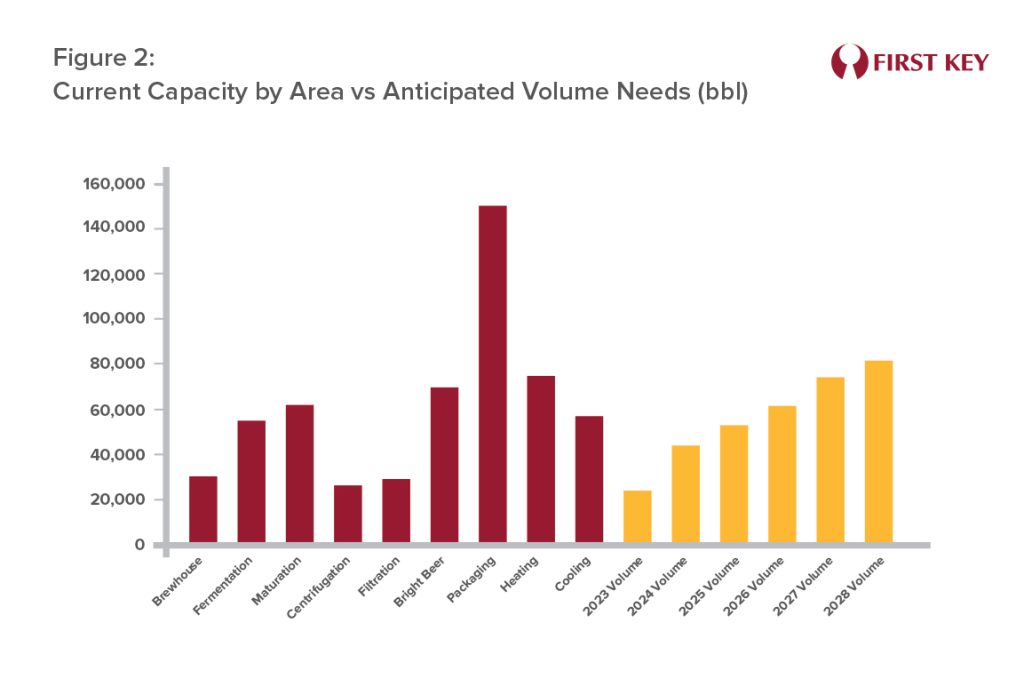As your brewery or beverage company considers major operational changes to meet business goals, having a proactive project management approach is essential. As part of that approach, the Planning Phase of any project is the most critical phase. Dedicating the appropriate development time, involving the right resources, and doing the right level and scope of “homework” at this early stage is the secret to final project success.
Making the decision to proceed with a major operational change or capital project needs to be a well-informed decision. Although there are always pressures for quick decision making, spending the necessary time to critically vet a project always yields a more impactful project which achieves the deliverables more completely and efficiently. As noted by Rod Waite, Director of Engineering Services at First Key, “the Planning Phase doesn’t have to add excessive time to the project schedule and executing this phase thoughtfully, with a solid team, will lead to less re-work and potential wasted investments down the road”. A well-developed project plan will provide the means to control and reduce project costs, as well as potentially improving its overall schedule. Waite adds that “as the implementation phase of the project progresses, the cost of changing course increases considerably”. In other words, plan well now, to save later!
The project framework below shows the overall Project Management Approach. As noted, the Planning Phase includes defining the needs and identifying the options, developing a conceptual plan and determining the project’s feasibility and funding. All of these aspects need to be carefully completed before a Go/No Go decision is made to move to the Execution Phase.

Defining the Objectives and the Project Scope
The critical first step is to clearly define the objectives and scope of the project. Often people hear the word “project” and assume that this involves some capital investment, but this is not necessarily the case. Projects can be heavily capital-focused, such as brewery expansions and upgrades. Examples of these include installing new fermentation tanks, automating cellars with control valves or adding packaging capacity. Examples of projects that are less capital-intensive while also complex may include the development of new brands or products, which involve recipe development, ingredient management, pilot trials, consumer testing and market research. Some projects involve both process changes (whether a physical brewery process or a business process) along with some investments in physical assets or upgrades. For instance, this is the case for projects dealing with the implementation of production software to better track the brewery’s business, production and material flows, or projects dealing with process optimization initiatives to reduce energy consumption. Outlining in detail the Brewery’s Needs and Options is essential to set a clear path forward for the initiative. Clearly defining the project’s goals helps to protect against scope creep, which is quite typical, especially in large projects, as stakeholders see a project as an opportunity to fix other unrelated issues: it is equally important to detail what the project includes and what it doesn’t. Project Managers should be vigilant to avoid scope creep from the start.
Identifying and developing suitable options for projects can seem like a daunting task. However, it is essential to explore multiple considerations and alternatives early in the project in order to ensure the project moves forward with the optimal solution. These options will further evolve and be refined over the duration of the Planning Phase as part of the Conceptual Planning and the Feasibility & Funding steps.
As the project scope is defined, it is important to be mindful of the implications that the project may have on other parts of the operation. For instance, a brewer may award contracts for a new packaging line, without considering the impacts that the new packaging line will have from the brewing and utilities areas, so that these areas provide the needed services to the packaging expansion. Moving forward with the packaging expansion prior to understanding these needs could leave the brewery with a major investment that can’t operate to its rated capacity because it is constrained by brewing or utilities or could lead to a much larger capital investment than budgeted.
Conceptual Planning
Once the project objectives are well defined, the best action is to develop a high level, conceptual plan to convert objectives into scope requirements which best satisfy the project needs. Some of the critical tools to consider when creating a Conceptual Plan include:
- Conceptual Technical Plan:
- Project Scope & Sequence – this provides a detailed action plan of tasks required to complete the project objectives and the sequence for these tasks.
- Alternatives & Options – this planning requires evaluating how to accomplish desired scope which could include Outsourcing production, process changes within the brewery or expansion.
- Careful management of Competing Priorities – it is important that project scopes take a full brewery view and consider impacts across the entire operation. Often a priority for one department can create a new challenge or issue for another.
- Other important aspects to consider:
- What quality impacts will the project scope create?
- How will the project scope improve operational efficiencies across the brewery?
- How will the project scope support the brewery’s environmental sustainability goals?
- Equipment Requirements List – this provides a list of equipment requirements and options to meet the project objectives.
- Layout Drawings – these drawings show the equipment additions and relocations within the footprint of the brewery. This space planning is critical to ensure proposed equipment changes can optimize available space within the brewery.
- Utilities Review & Modelling – this describes the current state and future state for the utility systems capabilities required to support the new or altered equipment and processes.
- Project Scope & Sequence – this provides a detailed action plan of tasks required to complete the project objectives and the sequence for these tasks.
- Conceptual Budget – this includes both capital and operating budget impacts. The more complex the scope is, the more complex or detailed the capital budget will need to be to fully understand the magnitude of the cost of the entire project.
- Conceptual Operating Budget Impacts – capital expansion or process improvements usually lead to improvement but also changes to operating budgets. Understanding these impacts is critical to understand the total financial impact.
- Conceptual Schedule – this schedule needs to include both the planning and the execution phases, so as to provide the timing when the project will deliver the proposed change in capability. Beer and beverage sales are very seasonal, so it is essential that the investments and the project execution be completed at the right time of year to achieve the optimal and desired benefits.
- Capacity Assessment & Modelling – the purpose of developing the capacity model is to evaluate the current state capacity compared to future volume demand. This allows for the process capacity gaps to be clearly identified, as illustrated in Figure 2. This analysis can also test how the proposed changes will impact capacity and the overall ability to achieve the desired volumes. It can help identify what the next capacity constraint will be. For further reading The Importance of Brewery Capacity Modeling for Long-Term Success

- Project Readiness – this evaluation tests how prepared the brewery is to navigate the change management required to accomplish the project’s scope.
- Strategic Planning – is the project aligned to the overall brewery strategic plan?
- Financial Planning – with the conceptual capital and operating budget impacts defined above, the impacts of financing, cashflow management and investor approval need to be defined.
- Resource Planning – in addition to external resources, this plan includes determining the necessary employee involvement to support the project, along with long-term impacts that the project will have on labor requirements once the project is implemented. It also includes designating the Project Manager: does your brewery have a person with the necessary skills and capacity to lead this change? This is an often-missed aspect of planning but typically one of the most important.
- Risk Planning – here we recognize that all changes involve risks. It is important to define these potential risks and to ensure that the conceptual scope, budget, and schedule can mitigate these risks as much as possible.
Feasibility & Funding Planning
All breweries have financial requirements and goals to deliver. Projects can help achieve these goals but understanding the path forward to optimize the financial benefits is essential. This is best addressed during the Planning Phase as minimum financial commitments have been made at that point and more options to arrive at the optimal solution can be found. This enables the brewery to select the optimal option which achieves the highest Return on Investment (ROI) while meeting all the project requirements of safety and quality.
Feasibility Studies can also include a technical component to evaluate various levels of investment and their corresponding output benefits. Often, a phased approach to a larger expansion project can be the most cost-efficient option for your brewery if you are looking to expand capabilities while also managing the risks. In this way, you can ensure a base ROI is achieved in the first phase prior to further expansion decisions, for instance.
Another more detailed aspect in Feasibility Planning is to complete a technical review and evaluation of the various options. This enables you to compare side-by-side equipment choices (e.g. packer types, packaging line sizes) and their levels of automation. The brewery equipment industry is full of options, so evaluating the equipment to determine which is the best fit for the project is essential to optimize your investment.
Funding planning is also a critical part of the planning process, as cashflow management is core to all businesses and projects typically generate unique spending patterns compared to your brewery’s typical operating cashflow. By using the conceptual capital and operating budgets, a projected funding schedule can be created to help your brewery work with investors and show them how the investments will need to be made, and how the expected savings or additional revenue will be scheduled to achieve the business objectives, including the cash flow requirements.
Go / No Go
In the end, the brewery will need to make a difficult, albeit exciting decision. With the proper level of oversight, analysis and project justification in the Planning Phase, the Go / No Go decision will be easier and better supported. These discussions and decisions are ultimately made by the brewery, with the benefit of input from all the key stakeholders, in a spirit of partnership. The roadmap we outlined will enable you to make the optimal Go/No Go decision with confidence before moving forward with the Execution Phase of your project.



